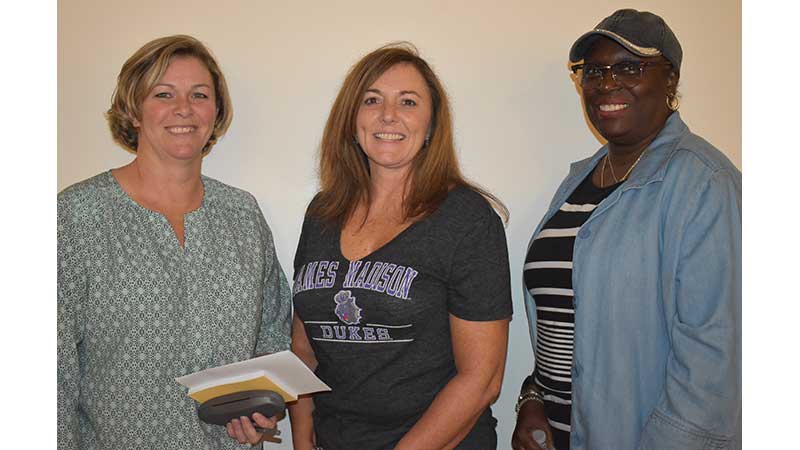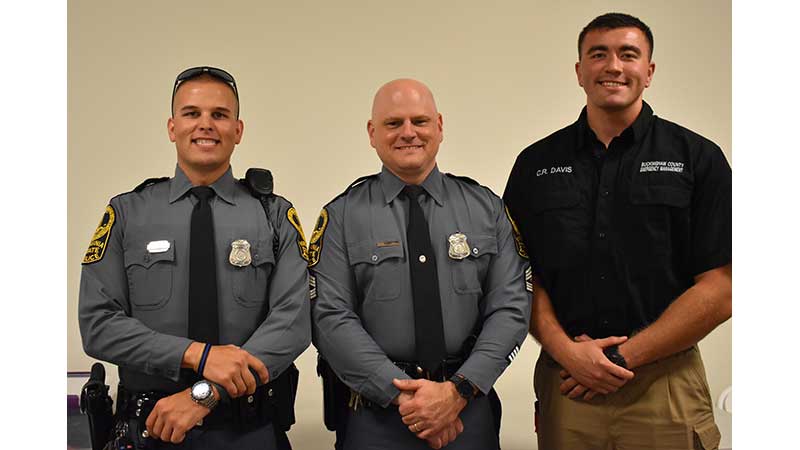Active shooter training held
Published 10:05 am Thursday, October 3, 2019
The Buckingham County Farm Bureau sponsored a response to active shooter training event Thursday, Sept. 26, at the Buckingham Agriculture Resource Network (BARN) building.
The event, presented by Sgt. Eric King of the Virginia State Police, aimed to help educate Buckingham community members about active shooter situations and how to think and act appropriately in a moment of crisis.
King explained that his program was put together by Texas State University (TSU) Advanced Law Enforcement Rapid Response Training (ALERRT), which helps to train first responders to be prepared for active shooter situations.
The event was a part of TSU Civilian Response to Active Shooter Events (CRASE) Avoid-Deny-Defend awareness program. A full-house of Buckingham residents gathered at the BARN to participate.
King’s presentation opened up with a clip of teacher Patti Nielson’s 911 call during the shooting that took place at Columbine High School on April 20, 1999. During the sound clip, a panicked Nielson speaks to a 911 operator as she attempts to hide a library full of highschool children from two gunmen.
King explained that Columbine was the day that changed the way that police respond to active shooter events. He went on to say that 10 of the 12 victims of the Columbine shooting were shot while hiding in the school’s library and that many people who have found themselves in an active shooter scenario, like Nielson, were not prepared with a plan for such events.
“You guys are gonna have a plan,” King told audience members Thursday night.
During his presentation, King noted that the ALERRT program uses author of “The Unthinkable” Amanda Ripley’s three stages of disaster response in order to teach civilians how they should react should an active shooter event arise. Ripley’s three stages included denial, deliberation and a decisive moment.
In Ripley’s book, “denial” in an active shooter event involves a “normalcy bias” that many people experience when faced with an active shooter scenario. For example, many civilians in an active shooter event may brush off the sound of gunshots to simply be fireworks. A normalcy bias, according to King, can be detrimental in an active shooter scenario.
When discussing the “deliberation” disaster response stage, King showed a video from the Station Nightclub fire that occurred on Feb. 20, 2003. King explained that the fire killed 100 of the concert-goers that had entered the nightclub, and that 31 of those victims died in the same doorway that they had entered the concert venue from. King explained that deliberation in the response of a disaster involves seeking alternative exits should immediate evacuation be necessary.
King’s presentation discussed the third stage of disaster response, the “decisive moment,” in the context of the Thalys train attack that occurred on Aug. 21, 2015. King referenced how Americans Anthony Sadler, Alek Skarlatos and Spencer Stone worked together to disarm a terrorist on the train heading from Amsterdam to Paris, and that their decisive moment came when Skarlatos exclaimed, “Let’s go!” as he and his friends headed toward the sound of gunfire.
King explained some data regarding active attack events. He cited that the attacker in these scenarios usually has an avenger mindset and that they often broadcast their plans on social media or via text message to friends. King stated that 96 percent of the time the attacker is male and that 98 percent of the time they are alone. The median age for an attacker, according to King, is 35.
King added that attackers in active shooting scenarios often come with a set of risk factors. He explained that attackers often have a history of violence, isolation and substance abuse. He also stated that many attackers have a history of mental illness, suicidal tendencies, negative family dynamics and a history of stalking others.
The presentation noted that over 50 percent of active attack events (including shootings, attacks with knives and attacks with cars) take place in areas of commerce such as businesses and workplaces. 24 percent of attacks happen in education settings like schools and colleges. 13 percent of attacks occur outdoors and 11 percent occur in other places such as hospitals or military bases.
Another statistic King revealed was that 55 percent of shooting victims are in some way connected to the shooter, while 45 percent have no connection at all.
At the end of his presentation, King went over the CRASE Avoid-Deny-Defend program steps for reacting in an active shooter scenario.
King explained that the “avoid” step starts with a person’s state of mind. Someone trying to avoid an active shooter must pay attention to their surroundings, have an exit plan and move away from the source of the threat as quickly as possible. The more distance and barriers between you and the attacker, the better.
The “deny” step becomes important when getting away from an attacker is difficult or impossible. One must keep their distance between the source of the threat and create barriers to slow down an attacker or prevent them access to a location. It is also important to turn the lights off and remain out of sight by hiding behind large objects or silencing your phone.
King noted that the “defend” step is important because citizens have the right to defend themselves. When faced with an attacker, King explained, individuals must be prepared to defend themselves. It is important to be aggressive and committed to your actions.
“This is not the time to fight fair,” King added.
The final step in the Avoid-Deny-Defend program is to call 911 when you are in a safe area and to inform the operator that you are in an active shooter situation.
King’s presentation stated that it was not recommended to play dead in an active shooter situation, or to hide and hope that the attacker will go away. He emphasized that civilians must go from being victims to victors by knowing how to respond to the event.
King added that it is necessary for anyone who finds themselves in an active shooter event to cooperate when police arrive. It is important to follow commands, show the palms of your hands and to not move from your location. He noted that police experience the same stress signals that civilians do when in these situations.
Trooper Clint Thackston, an alumnus of Virginia Tech, discussed the shooting that occurred on campus on April 16, 2007. Thackston showed audience members a floor plan of Norris Hall, one of the buildings that the attack took place in that morning. He explained the various steps that different students and faculty took to protect themselves from the shooter.
At the end of the presentation, King explained that neither he nor Thackston had mentioned the names of the attackers from any of the referenced tragedies. He explained that many shooters are motivated by gaining celebrity status from their acts and want their names to be remembered and associated with the events.
“Why not take away at least this one motivation?” King asked. He went on to say that it is the names of the victims that should be remembered instead.
Buckingham Emergency Management Coordinator Cody Davis helped to arrange the presentation. “The Farm Bureau approached me about wanting to sponsor a community-oriented training,” said Davis. “They had heard about the first responder training that we did a few months ago in regard to active shooters, and they asked if we could get something here for regular civilians. Of course, I’m all about community engagement and throughout trial and error I was able to come across Sgt. Eric King.”
Free gun locks were handed out during the presentation.






